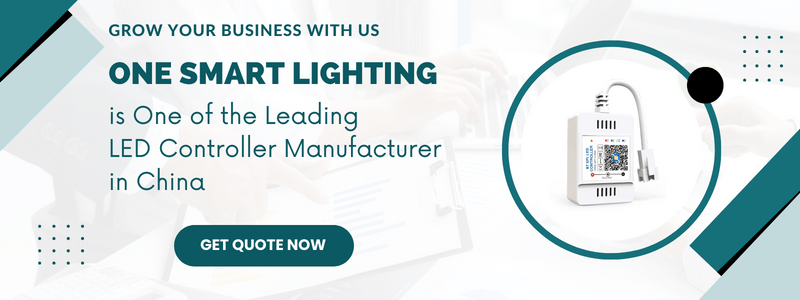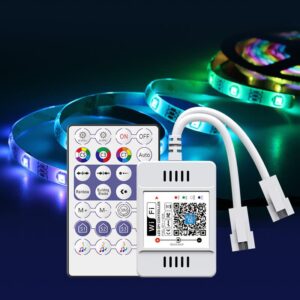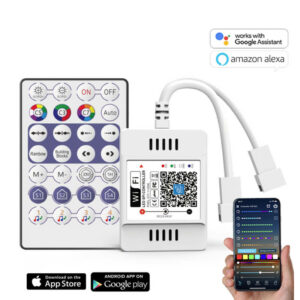Table of Contents
ToggleWhat is the LED pixel controller?
A LED pixel controller is a device that allows you to control the color and brightness of individual LED lights, often called “pixels”. These controllers typically use a serial protocol, such as SPI or UART, to send instructions to the pixels, which are then used to set the color and brightness of each individual LED.
LED pixel controllers are commonly used in lighting displays, such as in LED signs or decorative lighting installations. They can also be used in stage lighting to create intricate and dynamic lighting effects.
How LED Pixel Controllers Work
Delving into the intriguing world of LED technology, we find LED pixel controllers at the heart of the magic that brings LED strips to life. But how does an LED pixel controller work? Think of it as the conductor of a spectacular light orchestra, receiving, interpreting, and then orchestrating the command signals to the individual LEDs, or “musicians”. At the core of each controller, you’ll find a microcontroller – a compact, low-cost computer on a single integrated circuit. This is where the magic happens. The process begins when the microcontroller receives input signals from an external controlling device, like a computer or a mobile app, such as Surplife, through its input ports. These signals contain instructions on how each LED pixel should behave – their color, brightness, and timing.
After receiving these commands, the microcontroller has to interpret them. This is akin to decoding a secret language; the microcontroller translates the raw signals into a format it can use to orchestrate the pixels. Following this, the translated instructions are dispatched via the output ports to each LED pixel in a particular sequence and timing. This allows each LED pixel to function independently, displaying its unique color and brightness as commanded. The result is a dazzling display of lights, perfectly synchronized and organized to create the desired visual effect.
Additionally, advanced LED pixel controllers come equipped with unique features for enhanced performance. Some may include built-in color palettes, enabling you to select from a range of pre-defined colors for your display. Others might have automatic mode switching or even music synchronization capabilities, letting you choreograph light shows that move with the rhythm of the music. From digital billboards to home lighting setups, LED pixel controllers are the invisible maestros, directing a brilliant symphony of lights that enthralls and captivates.
In essence, the LED pixel controller is the brain that turns a collection of individual LED lights into a cohesive, dynamic visual display. Through the processing and interpretation of input signals and the subsequent direction of each LED pixel, these controllers allow for the creation of a harmonious light performance. Truly, LED pixel controllers are an integral part of what makes LED displays so mesmerizing and appealing.
Type of LED Pixel Controller
LED pixel controllers come in various types, including standard DMX controllers, computer-controlled systems, dedicated LED controllers, and stand-alone controllers. Each type of controller has its unique features and capabilities, so it is important to consider the intended use before selecting a controller.
There are several different types of LED pixel controllers, and the specific type you would use depends on the needs of your particular project. Some common types of LED pixel controllers include the following:
DMX controllers, which use the DMX protocol to control LED pixels
SPI controllers, which use the serial peripheral interface (SPI) to control LED pixels
DVI controllers, which use a DVI (digital visual interface) connection to control LED pixels
Ethernet controllers, which use an Ethernet connection to control LED pixels
WiFi controllers, which use a wireless connection to control LED pixels
Each type of pixel controller has its advantages and disadvantages, so it’s important to choose the right one for your project.
What are LED Pixel Controllers used for?
Addressable LED pixel controllers are used for a variety of purposes, including the following:
- Creating dynamic and interactive lighting displays: Pixel light controllers are often used to control the color and intensity of LED pixels in large lighting installations, allowing for complex and dynamic displays.
- Controlling stage lighting: In the entertainment industry, LED pixel controllers control the lighting on stages, allowing lighting designers to create intricate lighting effects.
- Enhancing architectural lighting: LED pixel controllers can control the lighting in buildings and other structures, allowing for more dynamic and flexible lighting designs.
- Enhancing visual displays: Pixel LED controllers are used in various visual displays, such as advertising displays, digital signage, and video walls, to create eye-catching and engaging visual experiences.
- Controlling holiday lighting: Addressable pixel LED controllers are often used in holiday lighting displays, allowing for complex and dynamic lighting effects that can be changed and controlled remotely.
Overall, LED pixel controllers are used in various applications where dynamic and customizable lighting is needed.
Things to know before choosing LED Pixel Controller
Before choosing an LED pixel controller, you should keep a few key things in mind to ensure that you choose the right one for your project. Here are some important factors to consider:
Compatibility: Make sure that the LED pixel controller you choose is compatible with the type of LED pixels you use. Different controllers are designed to work with different types of pixels, so it’s important to check that they are compatible before making a purchase.
Connection type: Consider the connection you will use to control the LED pixels. Different controllers use different types of connections, so you need to choose a controller that will work with your available connection.
Control capabilities: Consider what type of control you need for your LED pixels. Some controllers are simple and only allow you to change the color of the pixels, while others are more advanced and allow for more complex control and animation. Choose a controller that has the control capabilities you need.
Power requirements: Make sure you choose a controller that can handle the power requirements of your LED pixels. The pixels may not work properly if the controller doesn’t provide enough power.
The number of LED pixels you need to control: Different LED pixel controllers can control different numbers of LED pixels, so you need to make sure the controller you choose can handle the number of pixels you need.
The type of LED pixels you are using: Different controllers are compatible with different types of LED pixels, so you need to ensure the controller you choose is compatible with the pixels you have.
The type of lighting effects you want to create: Some controllers are more capable than others when creating complex lighting effects, so if you want to create elaborate displays, you might need a more advanced controller.
Your budget: LED pixel controllers can vary in price, so you must consider your budget when choosing a controller.
By considering these factors, you can ensure that you choose the right LED pixel controller for your project.
LED Pixel Controller Techniques
Several techniques can be used when working with LED pixel controllers, including the following:
- Chasing: Chasing is a technique in which the LED pixels are made to “chase” each other in a pattern. This can create the illusion of movement and can be used to create interesting lighting effects.
- Fading: Fading is a technique in which the intensity of the LED pixels is gradually changed over time. This can create a smooth transition between colors and can be used to create a range of different lighting effects.
- Twinkling: Twinkling is a technique in which the LED pixels are made to flash or flicker, creating the illusion of stars or other twinkling lights. This can be used to create a festive or magical atmosphere.
- Strobe lighting: Strobe lighting is a technique in which the LED pixels are made to flash rapidly, creating a strobe effect. This can be used to create a disorienting or exciting atmosphere or to create special effects in stage lighting.
- Chasing and fading together: By combining the chasing and fading techniques, it is possible to create complex and dynamic lighting effects that move and change over time. This can be used to create a wide range of interesting and engaging lighting displays.
The specific techniques used in a LED pixel controller project will depend on the goals and needs of the project.
In addition to the techniques mentioned above, it is possible to use an App to control smart SPI LED pixel controllers and create dynamic lighting effects.
This can be done by using a smartphone or tablet App to control the SPI LED pixel controller, allowing you to change the colors and intensity of the LED pixels in real time.
1. With an App, you can use the touchscreen interface to easily select colors and adjust the intensity of the LED pixels.
2. Some Apps also allow you to create and save lighting patterns and effects, which can be recalled and used again later.
3. Some Apps also allow you to control multiple App LED pixel controllers at once, allowing you to create coordinated lighting displays across multiple areas.
4. Using an App can make it easier to control Magic Home LED pixel controllers, especially if you are controlling many pixels or creating complex lighting effects.
Overall, using an App to control SPI LED pixel controllers can be a convenient and user-friendly way to create dynamic lighting effects.
Step to select a LED pixel controller.
To select an LED pixel controller, you can follow these steps:
1. Determine the number of LED pixels you need to control
This will help you choose a controller capable of handling the number of pixels you need.
2. Consider the type of LED pixels you are using
Different controllers are compatible with different types of LED pixels, so you need to ensure the controller you choose is compatible with the pixels you have.
3. Choose the type of connection you need
Different controllers use different connections to control the LED pixels, so you need to choose a controller that uses the type of connection you need.
4. Consider the type of lighting effects you want to create
Some controllers are more capable than others when creating complex lighting effects, so if you want to create elaborate displays, you might need a more advanced controller.
5. Consider your budget
Ws2811 LED pixel controllers can vary in price, so you need to consider your budget when choosing a controller.
6. Research different LED pixel controllers and read reviews
This can help you compare different controllers and make an informed decision about which one to choose.
7. Choose a controller and purchase it
Once you have selected the right controller for your project, you can purchase it and begin using it to control your LED pixels.
How do control LED Pixel Controller with APP?
If you want to control a WiFi LED pixel controller using an App, you will need to use a compatible controller. Some WiFi LED pixel controllers come with a companion App that can be used to control the controller and the LED pixels.
You will need to connect the controller to your device using Bluetooth or WiFi to use the App. Once the connection has been established, you can use the App to control the LED pixels. The specific steps for using an App to control a WiFi LED pixel controller will depend on the App and the controller you are using, so it’s important to carefully read the instructions provided by the controller and the App.
How to customize LED Pixel Controller for your light project?
To customize an Addressable LED pixel controller for your light project, you will need to use a controller that offers customization options and a computer program or app to configure the settings. Some Addressable LED pixel controllers come with a companion program or App that allows you to customize the controller settings and program the LED pixels to display the desired patterns or effects.
To customize the controller, you can use the program or App to select the colors and brightness of the LED pixels, set the speed at which the patterns are displayed, and create custom patterns or effects.
Some controllers may also offer advanced customization options, such as the ability to synchronize multiple controllers or integrate with other lighting systems. It’s important to carefully read the instructions provided with the controller to learn about its specific customization options and how to use them.
Why choose LED Pixel Controller for LED strip lights?
Ws2812b LED pixel controllers are designed specifically for use with LED strip lights. These controllers offer advanced features and customization options that allow you to create dynamic and visually impressive lighting effects using your LED strip lights.
With a ws2812b LED pixel controller, you can program the LED strip lights to display various patterns and effects, including color-changing, chasing, fading, and flashing. You can also customize the patterns’ colors, brightness, and speed to create the perfect lighting effect for your project.
Additionally, some LED pixel controllers offer advanced features, such as synchronizing multiple controllers or integrating with other lighting systems.
A LED pixel controller is a great way to enhance the capabilities of your LED strip lights and create unique and dynamic lighting effects.
Difference between LED Pixel Controller & RGB LED Controller
LED pixel controllers and RGB LED controllers are both controllers used to control LED lighting. The main difference between the two is in the way they control the LEDs.
A LED pixel controller is designed to control individual LEDs or small groups of LEDs, known as “pixels,” arranged in a grid or a strip. This allows the controller to create complex and dynamic lighting effects by independently controlling each pixel. On the other hand, an RGB LED controller is designed to control RGB (red, green, blue) LED strips or panels.
This type of controller allows you to mix the three primary colors to create a wide range of colors and lighting effects, but it does not offer the same level of fine-grained control as an LED pixel controller. Depending on the specific features and capabilities of the controller, either an LED pixel controller or an RGB LED controller can be used for a given lighting project.
How to Choose the Right LED Pixel Controller
When it comes to choosing the right LED pixel controller, the process can seem a bit daunting. However, armed with the knowledge of their working, types, and key features, you’ll be well-equipped to make an informed decision. Just remember, your choice should ultimately reflect the needs of your specific project.
Capacity
The capacity of the controller, which refers to the maximum number of pixels it can control, is of utmost importance. Depending on the scale of your project, you might need a controller with a higher capacity.
Power Source
The power source is another significant aspect. Controllers can be powered via an external power source or via a USB connection. Choose according to your setup’s requirements.
Compatibility
Compatibility with the type of LED lights you’re using is another vital factor. Not all controllers are compatible with all LED types, so ensure that your chosen controller matches your LEDs
Conclusion
In conclusion, LED pixel controllers are specialized devices that are used to control LED strip lights or other LED lighting systems. These controllers offer advanced features and customization options that allow you to create dynamic and visually impressive lighting effects.
LED pixel controllers can control individual LEDs or small groups of LEDs, known as “pixels,” allowing for fine-grained control and the ability to create complex patterns and effects. Depending on the specific features and capabilities of the controller, a LED pixel controller can be used for a wide range of lighting projects, from simple color-changing effects to sophisticated synchronized lighting displays.
LED pixel controllers are an essential tool for creating dynamic and impressive lighting effects using LED strip lights or other LED lighting systems.
We are a professional LED pixel controller manufacturer. Contact us today for expert consultation and to receive your high-quality LED pixel controller!
FAQs
- What is an LED pixel controller?
An LED pixel controller is a device that controls the color and brightness of individual LEDs within a display. - What are the main types of LED pixel controllers?
The two main types of LED pixel controllers are DMX and SPI pixel controllers. - What factors should I consider when choosing an LED pixel controller?
Key factors to consider include the controller’s capacity, power source, and compatibility with your LED lights. - What is the role of microcontrollers in LED pixel controllers?
Microcontrollers in LED pixel controllers store and execute the instructions that dictate the behavior of each LED pixel. - Are all LED pixel controllers compatible with all types of LEDs?
No, not all controllers are compatible with all types of LEDs. Always check the compatibility of your controller with your LED lights.




